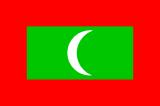The Maldives
The Republic of the Maldives, is a collection of 1,200 coral reef islands situated in the Indian Ocean to the south west of Sri Lanka.
The Venetian explorer Marco Polo (1254-1354 AD) referred to the Maldives as the "flower of the Indies", while the great Islamic scholar and traveler Ibn Batuta (circa 104-1368 AD) called the islands "one of the wonders of the world. Today the Maldives is often popularly known as the "pearls of the Indian Ocean".
The islands form an archipelago of 26 major atolls (groups of neighboring coral islands) stretching 820 km north to south and 120 km east to west for a total of approximately 90,000 km2. Only about 200 islands are inhabited, with 91 adapted as exclusive holiday resort islands.
Today the country's vibrant population stands at 385,925 (July 2008 est.) but this number is supplemented by the many tourists and migrant workers who flock to the Maldives every year. One third of the country's inhabitants reside in the capital Male, one of the most densely populated cities on Earth.
Those who visit these stunning islands never forget the pristine landscapes; the abundant marine life; the spectacular sunsets; and the warm and welcoming people!
In this section you will find more information on the country and her people.
Maldives History
The latest archaeological evidence suggests that the Maldives was first inhabited in around 1500 BC. It seems likely that the islands were first permanently settled by Aryan immigrants who are also believed to have colonized Sri Lanka at around the same time. Subsequent migrations at regular intervals, from Southern India and Sri Lanka, served to further expand the population of the Maldives.
Documented contact with the outside world began around 947 AD when Arab travelers began visiting the islands. Arab and Persian traders soon began arriving in large numbers, attracted to the Maldives by the abundance of pearls, spices, coconuts, dried fish and, in particular, cowry shells (which were accepted currency from Africa to China until the sixteenth Century).
These traders profoundly influenced Maldivian society and culture, with perhaps their most significant impact being in the religious sphere. The Maldives officially converted to Islam in 1153 AD and is today one of the few countries in the world with a 100% Sunni Muslim population.[1]
After the conversion to Islam, rulers of the Maldives islands came to be called Sultans. King Koimala was renamed Sultan Mohammed-bin-Abdullah and his Maley dynasty ruled the Maldives for 235 years under 26 different Sultans.
Maley rule was followed by the Hilali dynasty which held sway for over 170 years under 29 different Sultans. It was during Hilali rule (and in particular the reign of Sultan Kalhu Mohammed) that foreign powers were first invited to the Maldives to establish diplomatic and commercial relations - thus opening up the "pearls of the Indian Ocean" to the outside world.
However, the Maldives was to discover that the interests of foreign powers are rarely benevolent. In the mid-16th Century, Portugal invaded the Maldives and defeated Sultan Ali VI, the last ruler of the Hilali dynasty. Portuguese rule lasted for 15 years until they were eventually defeated by one of the Maldives' greatest national heroes, Mohammed Thakurufaan.
The dynasty established by Mohammed Thakurufaan - the Utheemu dynasty - was to rule the Maldives for the next 127 years (under 12 different Sultans) until the early 18th Century when foreign powers again began to turn covetous eyes on the islands. This time the threat came from the south coast of India from where the Raja of Cannanore dispatched a Malabar raiding party to attack Male. Although Maldivian forces eventually repelled the Malabar forces, the Utheemu dynasty collapsed and was replaced by the Huraage dynasty under the leadership of Ghazi Hassan Izzaddeen (which prevailed until 1968).
After the Malabar attack, the Maldives established diplomatic relations with Sri Lanka - an alliance that continued throughout the latter's Dutch and then British colonial periods. In 1887, the Maldives became a British Protectorate, not least to counterbalance the increasing influence of Borah merchants from Bombay. During the British era, which lasted until 1965, Maldives continued to be ruled under a succession of sultans; no formal British colonial administration was established.
The sultanate became an elected rather than a hereditary position when the islands' first constitution was drawn up in 1932. In 1953, there was a brief, abortive attempt at a republican form of government, after which the sultanate was restored. Following independence from Britain in 1965, the sultanate continued for another three years. On 11th November 1968, the Sultanate was replaced by an independent Republic of Maldives.
In the almost four decades since then, the country has constantly modernized and experienced rapid economic growth and significant improvement in most social indicators, rising from a social and economic backwater to a socially progressive and economically successful nation.
Political reforms have sped up the Maldives' development towards a vibrant multi-party democracy.
In 2008 the Maldives celebrated forty years as an independent Republic.
Language and culture
The national language of the Maldives is Dhivehi, a language which is placed in the Indro-Indian group of languages. Dhivehi has its roots in both Sanskrit and Elu, an ancient form of Sinhala spoken in Sri Lanka. It has also been influenced heavily by Arabic since the advent of the Islam in 1153 and English in more recent times. Given the wide dispersion of the vocabulary and pronunciation vary from atoll to atoll, with the difference being more significant in the dialects spoken in the southernmost atolls.
The Maldivian script known as thaana was invented during the 16th century soon after the country was liberated from Portuguese rule. Thaana is written from right to left, mainly to accommodate Arabic words that are frequently used in Dhivehi. There are 24 letters in the thaana alphabet.
English is the principle language of instruction in schools and so the bulk of the population in Malé and the tourist resorts speak English.
Maldives culture has been strongly influenced by its dispersed geography, with groups of islanders living in relative isolation on small islands. The extended family plays an important social role. Traditionally men focus on fishing and women are responsible for looking after the family and the community issues; and this is still so even today in smaller island communities.
Since Maldives adopted Islam in 1153 it has been central to the life of Maldivians. The main events and festivals of Maldivian life follow the Muslim Calendar. Children are taught the Arabic alphabet, and religious education is provided both at home and at school. Islam is part of the school curriculum and is taught concurrently with other subjects.
As the Maldives comprises more sea than land, fish (mainly tuna) has always been the most prominent element of Maldivian food. With the Maldives located at an important crossroad in the Indian Ocean, traders and visitors brought new seasonings and vegetables to the country and added to the existing repertoire of seafood and tubers (e.g. taro & sweet potato). Maldivian cuisine now comprises Arabic, Indian, Sri Lanka and Oriental tastes blended into a unique style.
Arts and Crafts play an important role in Maldives' society. Stone carving has long been an area of expertise; beautifully carved tombstones in many old cemeteries and the fine stone carvings of the Hukuru Miskiiy Mosque in Male' are examples of this. Calligraphy, an art with strong connections with Islam, is practiced and decorative Quoran verses can be found in mosques around the country and in the Islamic Center.
Wooden lacquer ware is perhaps the most distinctive of the Maldivian handicrafts; the elegant pieces are made from the local funa tree which grows abundantly throughout the country. They are lacquered in strands of red, black and yellow resin and delicately carved with flowing flowery patterns. Beautiful reed mats decorated with intricate abstract designs still woven on handlooms are another outstanding example of craftsmanship.
As to be expected for an island nation, boat building is an ancient craft. The traditional ‘dhonis' used to be made from coconut wood, held together by coir and propelled by a square coconut frond sail. Today's designs use imported hardwoods, copper rivets and a triangular lateen sail; often supplemented by a diesel motor. Dhonis come in many sizes, from small personal boats to 30m luxury cruise vessels, but all use the same basic hull design.
Bodu Beru' is the most popular form of music and dance in the Maldives, probably introduced to the country in the early 19th century by African slaves. Three or four drums made from hollowed coconut wood and covered on both ends with manta ray skin or goat hide are used; a lead singer chants the lyrics and a chorus of 10 to 15 follows as they clap to the beat of the drums and dancers join in until the song reaches a crescendo. Other dances include Thaara (introduced from the Middle East) and Dhandijehun, Bandiyaa Jehun (a dance performed by young women carrying metal water pots and singing while taping the rhythm on the pots with rings worn on the fingers) as well as the traditional raivaru, farihi and bandhi styles.
Islamic festivals such as Ramadan and the Prophet's birthday are observed in the Maldives, other celebrations include Eid-ul Al'h'aa (the longest holiday of the year with 5-7 days), Bodumaloodhu (the naming ceremony for a newborn child), and the circumcision ceremony for the male child.
Geography
The Maldives is a chain of 1,190 small islands stretching across the equator to the south west of Sri Lanka. The 1,190 islands - of which only 190 are inhabited - form an archipelago of 26 natural atolls (groups of neighboring coral islands). Each of the 26 atolls that make up the Maldives is enclosed by a coral reef cut by several deep, natural channels and a lagoon.
The Maldives archipelago stretches 823 km north to south and 130 km east to west. Over 99% of the Maldives territory consists of water; only 115 square miles (298 square km) is dry land.
Together with the Lakshadweep Islands to the north (formerly part of the Maldives, now part of India) and the Chagos Islands to the south, the Maldives form part of a vast submarine mountain range, on the crest of which coral reefs have grown.
How the islands actually formed is unclear. One theory proposed by Charles Darwin in 1842 (after he had studied similar atolls in the Pacific and Atlantic Oceans) suggests that the islands were formed by volcanoes rising from the seabed towards the surface, with coral reefs growing around their edges. The volcanoes later collapsed back into the sea leaving behind the coral reefs enclosing shallow water-filled lagoons. Islands formed when currents and tides swept dead coral and other organic debris into the lagoons, which were then colonized by plants and trees.
The islands that make up the Maldives are very small (most can be walked across in 10 minutes; only a few are longer than 2 kilometers) and low-lying (they rarely reach more than six feet above sea-level). This makes them particularly vulnerable to sea erosion. In 1812 and again in 1955, devastating gales destroyed many northern islands, while in 1987 the capital, Male, was flooded by a severe storm. In 2004, a severe tsunami wreaked havoc on the entire nation, and in 2007 strong swells caused extensive damage.
The geography and topography of the islands mean that the Maldives is at the forefront of global climate change. The change in the Earth's climate system represents major social and political challenges for all the nations on Earth. For the Maldives it is nothing short of an existential crisis. The rising sea levels threaten the long-term viability of this island nation. In the medium-term the warming and acidification of the oceans threaten the prized coral reefs. These immediate and far reaching dangers led the Maldives to be described as a "nation in peril".











